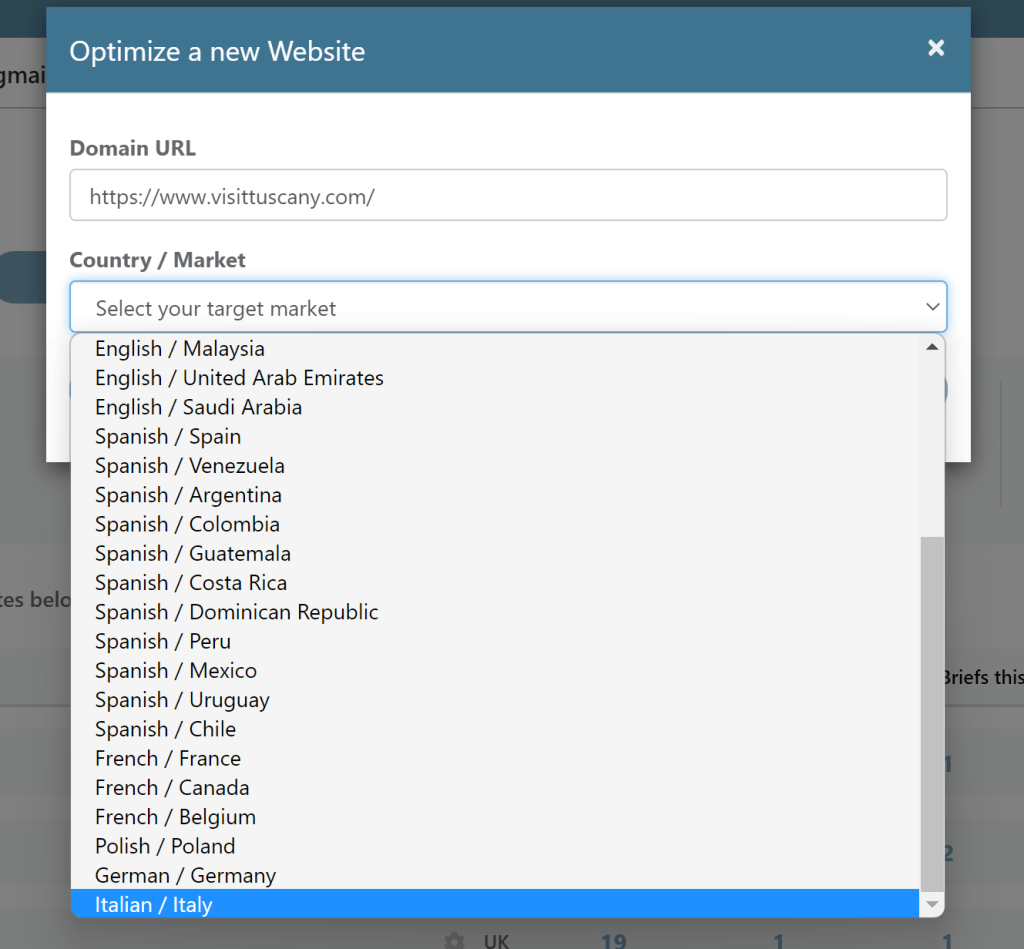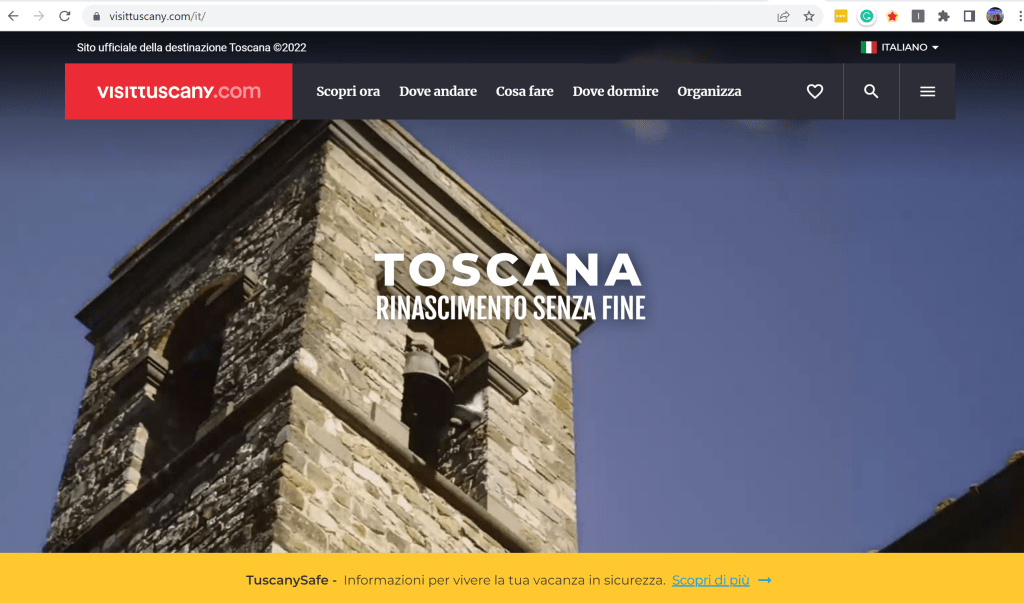Inlinks can now help you optimize Internal links, content, and Schema on Italian websites.

Inlinks is a new breed of SEO technology, which was built, from the ground up, around Entities and being able to extract them from any corpus of text and create a knowledge graph from the content, which is then used for SEO purposes.
Now, InLinks is able to “Read” content in Italian and extract the underlying entities (or topics) from the content. By doing this over a whole website, or even over a number of pages. InLinks can understand which topics are most important/cited on the web property and more importantly, it can work out what topics are connected to each other and in what context.
Let’s take an Italian website and see how this works.
I am going to consider the phrase “luoghi da vedere in Toscana” which means “places to visit in Tuscany”. Somewhere on page 3 of the results is a significant looking website, visittuscany.com which is in several languages, but Italian is of course at its heart.

When you start any project in InLinks, you need to specify both a website and a language/location combination. This is because InLinks leverages Google’s search API and the API requires a given version of Google when we make the call.
the first thing we do is to look up how many pages are indexed in Google for the site and use this to make suggestions as to how many pages you might want to add to InLinks. For the largest websites (like this one) we stop at 2,000 pages, but you are under no obligation to go that high. If you go for 100 pages, you can probably use InLinks and get value for around €33 per month. I’m going to just do the demonstration with just 50 pages!

A Knowledge Graph of an Italian Website
The above Topic Wheel is a visualization of the Knowledge Graph created by InLinks for this site in under a minute. You can see that InLinks has really understood the underlying concepts being discussed on the site. Importantly for SEO, you can also see what Google reports (in green) with its own NLP AI. Over the last few years, InLinks has been comparing the efficacy of its own algorithm for extracting entities from text with Google’s own API. Typically, Google only reports 15% of the underlying entities that InLinks sees in a given passage of text. In this example, topics in Green have been picked up by Google, but not always 100% of the time. By contrast, only ONE topic (Venezia) was reported by Google, which was not seen by the InLinks algorithm
So now we have a machine-readable database of topics, which we know Google will understand because we can relate all of these topics back to specific entity ID numbers (but we help to visualize by humans by using Wikipedia articles).
Using Inlinks to Automate Internal Links in Italian.
Now that we have a knowledge graph of every topic, right down to the anchor text that discusses it on every web page, it becomes trivial (for the user, at least) to automate Internal links. Simply set a “Target Page” for any given topic, and all other (relevant) mentions of the topic will link through to the target page. Let’s see it in action, using the page on “Grosseto”. We just select this as the principal purpose for the content on this page. In doing so, we can see that there might be 4 other mentions of Grosseto in the knowledge graph. Some of these might be good candidates for an Internal link or two.

After some analysis in the background, InLinks has not only found a good link candidate but has inserted it into the web page! (Note – this is only a demo. For the link to actually be inserted, the website owner would need to add a single line of javascript to the site. This manages all the internal linking and the schema generated by InLinks.) This site already has a very sophisticated internal linking setup, but even in this case, InLinks was able to find a needle in a haystack, and generate the link in context.

Using InLinks to Automate Schema on Italian Sites
As soon as the “human in the loop” sets a target topic for a web page, InLinks can also generate a semantic schema for the page (and insert it). Here is the schema that was generated when we set the target for the Grosseto page above.

In this schema, we are saying to a Search Engine that the page is MAINLY about Grosseto. To help a search engine know exactly what “Grosseto” is and to avoid confusion, the (English) Wikipedia page is shown. If we had found a good page in Italian, we may have used this, but either way, a modern search engine should now know that whilst this page MENTIONS San Lorenzo and passeggiata – which may provide context, the main topic of the page is Grosseto.
Using InLinks to optimize Content in Italian
The last important feature to show is how InLinks uses the same ideas of turning text into its underlying Knowledge Graph to help optimize existing content. The system can also be used for creating new content. Let’s return to our phrase “phrase “luoghi da vedere in Toscana” which means “places to visit in Tuscany” which means “places to visit in Tuscany”. This page is the candidate page for this phrase:
https://www.visittuscany.com/it/idee/gita-dinverno-in-toscana-scopri-5-borghi-da-favola/
In fact, it might be better to start from scratch and make it part of a topic cluster, as this page focuses on winter-based ideas… but for effect, let’s audit the page around that phrase. In doing so, we:
- Take the top 10 pages in Italy for the phrase.
- Build a knowledge graph of all 10 pages combined
- Show a gap analysis, by topic.
Here is what we get:

We can easily start to see that in order to be more authoritative around the subject, we should maybe talk about Pisa and Firenze. we can click on “Firenze” to see the underlying entity and closely related topics which should help us to do that.
Over to you. Yes – you get a Free Version
The Free version of InLinks does not read pages as well as the paid version, but you at least get 20 pages for free and can do an audit every month. If you splash out €22 Euros per 100 pages you upload, however, you will generate better links and create better content audits. We hope you will try InLinks or – if your English is better than our Italian, you can book a demo.
The tool now works in six languages:
You can vote for yours on our Language Roadmap survey.
*Further Reading:
https://ai.googleblog.com/2020/02/exploring-transfer-learning-with-t5.html




Leave a Reply
Want to join the discussion?Feel free to contribute!